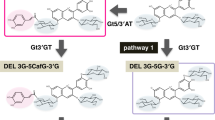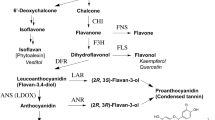Abstract
Main conclusion
UDP-glucose:flavonoid 3- O -glucosyltransferase is essential for maintaining proper production quantity, acylation, and glucosylation of anthocyanin, and defects cause pale and dull flower pigmentation in morning glories.
The Japanese (Ipomoea nil) and the common (I. purpurea) morning glory display bright blue and dark purple flowers, respectively. These flowers contain acylated and glucosylated anthocyanin pigments, and a number of flower color mutants have been isolated in I. nil. Of these, the duskish mutants of I. nil produce pale- and dull-colored flowers. We found that the Duskish gene encodes UDP-glucose:flavonoid 3-O-glucosyltransferase (3GT). The duskish-1 mutation is a frameshift mutation caused by a 4-bp insertion, and duskish-2 is an insertion of a DNA transposon, Tpn10, at 1.3 kb upstream of the 3GT start codon. In the duskish-2 mutant, excision of Tpn10 is responsible for restoration of the expression of the 3GT gene. The recombinant 3GT protein displays expected 3GT enzymatic activities to catalyze 3-O-glucosylation of anthocyanidins in vitro. Anthocyanin analysis of a duskish-2 mutant and its germinal revertant showing pale and normal pigmented flowers, respectively, revealed that the mutation caused around 80 % reduction of anthocyanin accumulation. We further characterized two I. purpurea mutants showing pale brownish-red flowers, and found that they carry the same frameshift mutation in the 3GT gene. Most of the flower anthocyanins in the mutants were previously found to be anthocyanidin 3-O-glucosides lacking several caffeic acid and glucose moieties that are attached to the anthocyanins in the wild-type plants. These results indicated that 3GT is essential not only for production, but also for proper acylation and glucosylation, of anthocyanin in the morning glories.




Similar content being viewed by others
Abbreviations
- 3GT:
-
UDP-glucose:flavonoid 3-O-glucosyltransferase
- 5GT:
-
Anthocyanin 5-O-glucosyltransferase
- F3′H:
-
Flavonoid 3′-hydroxylase
- qRT-PCR:
-
Quantitative reverse transcription-PCR
- TKS:
-
Tokyo-kokei standard
References
Behm-Ansmant I, Kashima I, Rehwinkel J, Sauliere J, Wittkopp N, Izaurralde E (2007) mRNA quality control: an ancient machinery recognizes and degrades mRNAs with nonsense codons. FEBS Lett 581:2845–2853
Chang SM, Lu Y, Rausher MD (2005) Neutral evolution of the nonbinding region of the anthocyanin regulatory gene Ipmyb1 in Ipomoea. Genetics 170:1967–1978
Chen WH, Hsu CY, Cheng HY, Chang H, Chen HH, Ger MJ (2011) Downregulation of putative UDP-glucose: flavonoid 3-O-glucosyltransferase gene alters flower coloring in Phalaenopsis. Plant Cell Rep 30:1007–1017
Chopra S, Hoshino A, Boddu J, Iida S (2006) Flavonoid pigments as tools in molecular genetics. In: Grotewold E (ed) The science of flavonoids. Springer, New York, pp 147–173
Conti E, Izaurralde E (2005) Nonsense-mediated mRNA decay: molecular insights and mechanistic variations across species. Curr Opin Cell Biol 17:316–325
Dooner HK, Nelson OE (1977) Genetic control of UDPglucose:flavonol 3-O-glucosyltransferase in the endosperm of maize. Biochem Genet 15:509–519
Fedoroff NV, Furtek DB, Nelson OE (1984) Cloning of the bronze locus in maize by a simple and generalizable procedure using the transposable controlling element Activator (Ac). Proc Natl Acad Sci USA 81:3825–3829
Fukada-Tanaka S, Inagaki Y, Yamaguchi T, Saito N, Iida S (2000) Colour-enhancing protein in blue petals. Nature 407:581
Fukuchi-Mizutani M, Okuhara H, Fukui Y, Nakao M, Katsumoto Y, Yonekura-Sakakibara K, Kusumi T, Hase T, Tanaka Y (2003) Biochemical and molecular characterization of a novel UDP-glucose:anthocyanin 3′-O-glucosyltransferase, a key enzyme for blue anthocyanin biosynthesis, from gentian. Plant Physiol 132:1652–1663
Habu Y, Hisatomi Y, Iida S (1998) Molecular characterization of the mutable flaked allele for flower variegation in the common morning glory. Plant J 16:371–376
Hagiwara T (1954) Recent genetics on flower-colour of Japanese morning glory with reference to biochemical studies. Bull Res Coll Agric Vet Sci Nihon Univ 3:1–15
Hagiwara T (1956) Genes and chromosome maps in the Japanese morning glory. Bull Res Coll Agric Vet Sci Nihon Univ 5:34–56
Hoshino A, Morita Y, Choi JD, Saito N, Toki K, Tanaka Y, Iida S (2003) Spontaneous mutations of the flavonoid 3′-hydroxylase gene conferring reddish flowers in the three morning glory species. Plant Cell Physiol 44:990–1001
Hoshino A, Park KI, Iida S (2009) Identification of r mutations conferring white flowers in the Japanese morning glory (Ipomoea nil). J Plant Res 122:215–222
Iida S, Hoshino A, Johzuka-Hisatomi Y, Habu Y, Inagaki Y (1999) Floricultural traits and transposable elements in the Japanese and common morning glories. Annal New York Acad Sci 870:265–274
Iida S, Morita Y, Choi JD, Park KI, Hoshino A (2004) Genetics and epigenetics in flower pigmentation associated with transposable element in morning glories. Adv Biophys 38:141–159
Imai Y (1931) Analysis of flower colour in Pharbitis nil. J Genet 24:203–224
Imai Y (1935) Recurrent reversible mutations in the duskish allelomorphs of Pharbitis Nil. Z Indukt Abstamm Vererb 68:242–264
Inagaki Y, Hisatomi Y, Suzuki T, Kasahara K, Iida S (1994) Isolation of a Suppressor-mutator/Enhancer-like transposable element, Tpn1, from Japanese morning glory bearing variegated flowers. Plant Cell 6:375–383
Inagaki Y, Johzuka-Hisatomi Y, Mori T, Takahashi S, Hayakawa Y, Peyachoknagul S, Ozeki Y, Iida S (1999) Genomic organization of the genes encoding dihydroflavonol 4-reductase for flower pigmentation in the Japanese and common morning glories. Gene 226:181–188
Kondo T, Kawai T, Tamura H, Goto T (1987) Structure determination of heavenly blue anthocyanin, a complex monomeric anthocyanin from the morning glory Ipomoea tricolor, by means of the negative NOE method. Tetrahedron Lett 28:2273–2276
Kubo H, Nawa N, Lupsea SA (2007) Anthocyaninless1 gene of Arabidopsis thaliana encodes a UDP-glucose:flavonoid-3-O-glucosyltransferase. J Plant Res 120:445–449
Larson RL, Coe EH Jr (1977) Gene-dependent flavonoid glucosyltransferase in maize. Biochem Genet 15:153–156
Lu TS, Saito N, Yokoi M, Shigihara A, Honda T (1992a) Acylated pelargonidin glycosides in the red-purple flowers of Pharbitis nil. Phytochemistry 31:289–295
Lu TS, Saito N, Yokoi M, Shigihara A, Honda T (1992b) Acylated peonidin glycosides in the violet-blue cultivars of Pharbitis nil. Phytochemistry 31:659–663
Lu Y, Xie L, Chen J (2012) A novel procedure for absolute real-time quantification of gene expression patterns. Plant Methods 8:9
Matsuba Y, Sasaki N, Tera M, Okamura M, Abe Y, Okamoto E, Nakamura H, Funabashi H, Takatsu M, Saito M, Matsuoka H, Nagasawa K, Ozeki Y (2010) A novel glucosylation reaction on anthocyanins catalyzed by acyl-glucose-dependent glucosyltransferase in the petals of carnation and delphinium. Plant Cell 22:3374–3389
Morita Y, Hoshino A, Kikuchi Y, Okuhara H, Ono E, Tanaka Y, Fukui Y, Saito N, Nitasaka E, Noguchi H, Iida S (2005) Japanese morning glory dusky mutants displaying reddish-brown or purplish-gray flowers are deficient in a novel glycosylation enzyme for anthocyanin biosynthesis, UDP-glucose:anthocyanidin 3-O-glucoside-2″-O-glucosyltransferase, due to 4-bp insertions in the gene. Plant J 42:353–363
Morita Y, Saitoh M, Hoshino A, Nitasaka E, Iida S (2006) Isolation of cDNAs for R2R3-MYB, bHLH and WDR transcriptional regulators and identification of c and ca mutations conferring white flowers in the Japanese morning glory. Plant Cell Physiol 47:457–470
Morita Y, Takagi K, Fukuchi-Mizutani M, Ishiguro K, Tanaka Y, Nitasaka E, Nakayama M, Saito N, Kagami T, Hoshino A, Iida S (2014) A chalcone isomerase-like protein enhances flavonoid production and flower pigmentation. Plant J 78:294–304
Neuffer MG, Coe EH, Wessler S (1997) Mutants of maize. Cold Spring Harbor Laboratory Press, Cold Spring Harbor, New York
Ogata J, Kanno Y, Itoh Y, Tsugawa H, Suzuki M (2005) Plant biochemistry: anthocyanin biosynthesis in roses. Nature 435:757–758
Ohnishi M, Fukada-Tanaka S, Hoshino A, Takada J, Inagaki Y, Iida S (2005) Characterization of a novel Na+/H+ antiporter gene InNHX2 and comparison of InNHX2 with InNHX1, which is responsible for blue flower coloration by increasing the vacuolar pH in the Japanese morning glory. Plant Cell Physiol 46:259–267
Park KI, Ishikawa N, Morita Y, Choi JD, Hoshino A, Iida S (2007) A bHLH regulatory gene in the common morning glory, Ipomoea purpurea, controls anthocyanin biosynthesis in flowers, proanthocyanidin and phytomelanin pigmentation in seeds, and seed trichome formation. Plant J 49:641–654
Petrussa E, Braidot E, Zancani M, Peresson C, Bertolini A, Patui S, Vianello A (2013) Plant flavonoids-biosynthesis, transport and involvement in stress responses. Int J Mol Sci 14:14950–14973
Saito N, Tatsuzawa F, Yoda K, Yokoi M, Kasahara K, Iida S, Shigihara A, Honda T (1995) Acylated cyanidin glycosides in the violet-blue flowers of Ipomoea purpurea. Phytochemistry 40:1283–1289
Saito N, Tatsuzawa F, Yokoi M, Kasahara K, Iida S, Shigihara A, Honda T (1996) Acylated pelargonidin glycosides in red-purple flowers of Ipomoea purpurea. Phytochemistry 43:1365–1370
Saito N, Tatsuzawa F, Kasahara K, Iida S, Honda T (1998) Acylated cyanidin 3-sophorosides in the brownish-red flowers of Ipomoea purpurea. Phytochemistry 49:875–880
Saito N, Toki K, Morita Y, Hoshino A, Iida S, Shigihara A, Honda T (2005) Acylated peonidin glycosides from duskish mutant flowers of Ipomoea nil. Phytochemistry 66:1852–1860
Sijen T, Vijn I, Rebocho A, van Blokland R, Roelofs D, Mol JN, Kooter JM (2001) Transcriptional and posttranscriptional gene silencing are mechanistically related. Curr Biol 11:436–440
Tanaka Y, Sasaki N, Ohmiya A (2008) Biosynthesis of plant pigments: anthocyanins, betalains and carotenoids. Plant J 54:733–749
Tohge T, Nishiyama Y, Hirai MY, Yano M, Nakajima J, Awazuhara M, Inoue E, Takahashi H, Goodenowe DB, Kitayama M, Noji M, Yamazaki M, Saito K (2005) Functional genomics by integrated analysis of metabolome and transcriptome of Arabidopsis plants over-expressing an MYB transcription factor. Plant J 42:218–235
Toki K, Saito N, Iida S, Hoshino A, Shigihara A, Honda T (2001a) Acylated pelargonidin 3-sophoroside-5-glucoside from the flowers of the Japanese morning glory cultivar ‘Violet’. Heterocycles 55:1241–1248
Toki K, Saito N, Iida S, Hoshino A, Shigihara A, Honda T (2001b) A novel acylated pelargonidin 3-sophoroside-5-glucoside from greyish-purple flowers of the Japanese morning glory. Heterocycles 55:2261–2267
Toki K, Saito N, Morita Y, Hoshino A, Iida S, Shigihara A, Honda T (2004) An acylated pelargonidin 3-sophoroside from the pale-brownish red flowers of Ipomoea nil. Heterocycles 63:1449–1454
Winkel BSJ (2004) Metabolic channeling in plants. Annu Rev Plant Biol 55:85–107
Yamazaki M, Gong Z, Fukuchi-Mizutani M, Fukui Y, Tanaka Y, Kusumi T, Saito K (1999) Molecular cloning and biochemical characterization of a novel anthocyanin 5-O-glucosyltransferase by mRNA differential display for plant forms regarding anthocyanin. J Biol Chem 274:7405–7411
Zufall RA, Rausher MD (2003) The genetic basis of a flower color polymorphism in the common morning glory (Ipomoea purpurea). J Hered 94:442–448
Acknowledgments
We thank Dr. Norio Saito for his participation in valuable discussions, Miwako Matsumoto, Chisato Matsuda, Ryoko Nakamura, Tomoyo Takeuchi, and Kazuyo Ito for their technical assistance, and the NIBB Model Plant Research Facility and the NIBB Functional Genomics Facility for the technical support. We also thank the National Bioresource Project Morning Glory and Dr. Eiji Nitasaka for Ipomoea seeds. This work was supported by grants, Grant-in-Aid for Scientific Research (No. 17207002 to S. I. and No. 18770041 to A. H.) from the Ministry of Education, Culture, Sports, Science and Technology.
Conflict of interest
The authors declare that they have no conflict of interest.
Author information
Authors and Affiliations
Corresponding authors
Additional information
Special topic: Polyphenols: biosynthesis and function in plants and ecosystems. Guest editor: Stefan Martens.
Electronic supplementary material
Below is the link to the electronic supplementary material.
Rights and permissions
About this article
Cite this article
Morita, Y., Ishiguro, K., Tanaka, Y. et al. Spontaneous mutations of the UDP-glucose:flavonoid 3-O-glucosyltransferase gene confers pale- and dull-colored flowers in the Japanese and common morning glories. Planta 242, 575–587 (2015). https://doi.org/10.1007/s00425-015-2321-5
Received:
Accepted:
Published:
Issue Date:
DOI: https://doi.org/10.1007/s00425-015-2321-5




